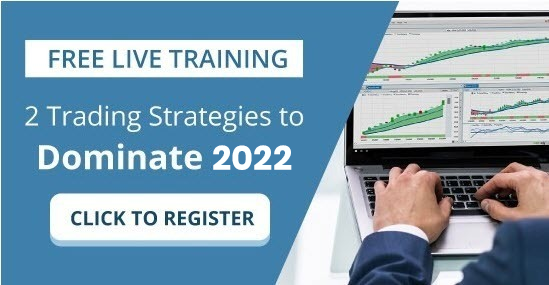
One of the questions I constantly ask myself relates to trying to define intelligence effectively and narrowly and then applying that understanding to trading. What I’ve always found helpful in trading endeavors is cultivating a process for asking great questions. Curious people tend to ask great questions. They want to understand how and why things work the way they do. They see the world as a cause-and-effect machine, and their curiosity helps them uncover the hidden gears and workings. Asking great questions is also a sign of intelligence. It takes a certain level of mental agility to quickly process new information and identify gaps in understanding. And finally, curiosity is contagious. People who always ask great questions tend to be stimulating conversationalists, drawing others into their line of inquiry.
Many traders are only concerned with the direction of the market which certainly is a result we are all interested in. But I’ve always been fascinated with the thought process and line of inquiry that allows discernment to occur and differentiates dangerous market environments from real opportunities. In this article, we’ll explore how traders can observe what is happening in the world, ask questions, and develop great trading ideas.
One of my mentors taught me the financial markets are like the ocean. Often they are tranquil, beautiful, and easy to navigate. But there are times when they are treacherous beyond description. The challenge for traders is to develop the tools, instincts, and resources to be able to differentiate a dangerous environment from a legitimate trading opportunity.
Last week I wrote about the European Energy Crisis. The point was simply to pose some basic and important questions. Energy is life. If an entire continent is deprived of energy, how does that affect its trading partners and neighbors? How will geographical borders and allegiances change in the next 6 months based upon the reality that Europe has no natural gas for heating and electricity prices have increased 700%? Most importantly, how does what is happening in Europe affect your portfolio?
The purpose of these questions is simply to provide a starting point to intelligent inquiry.
Let me share with you one chart that makes me conclude that what is happening in Europe is going to be worse than catastrophic.
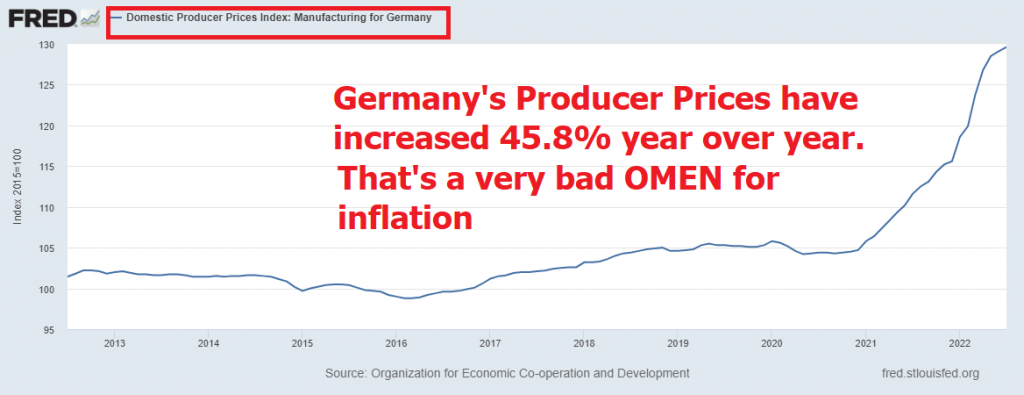
The chart above shows that Producer Prices in Germany increased by 45.8% year over year. This is the highest level of increase since they began tracking it. So, in keeping with my theme of asking good questions, as we go into winter, will producer prices increase over the coming month or decrease?If producer prices are increasing at this rapid pace, is it a fair assumption that we can expect inflationary pressures in Germany to also increase?
If Producer Prices in Germany continue to increase what does that do to the Eurozone?
Inflation is defined as a sustained increase in the general price level of goods and services in an economy over a period. The most flagrant cause of inflation, but one of the most common, is currency debasement. This occurs when the government prints more money than the amount of goods and services that have been produced, causing the value of the currency to decrease. This new, debased currency then circulates through the economy and drives up prices. The Producer price index (PPI) measures changes in the prices received by domestic producers for their output. An increase in PPI signals inflationary pressures in the economy because higher production costs will be passed on to consumers as higher prices for goods and services.
Inflation can have several negative impacts on an economy, such as discouraging investment and saving, decreasing international competitiveness, and reducing living standards. Hyperinflation is also something that can also not be ruled out as these types of price increases can quickly lead towards economic collapse.
One starting point for questioning what is happening in the world is simply asking something that is patently obvious and inquiring, “why?” Over the last year in the United States, we have seen Consumer Prices increase by 9.1% at its peak and it has been difficult for consumers and producers. Imagine, how challenging it is in Germany with a 45.8% increase in producer prices! Germany is the most productive country in the EU.
This graph measures from August 2021 to August 2022. As the weather gets colder and Europe freezes over what threat does that pose?
So here are some basic questions which act as good starting points for developing trading ideas:
- What rationale is there for investing in the EURO or Europe?
- What would need to occur to create a positive and safer environment to invest in the Euro?
- What would force Producer Prices to drop dramatically in Germany? How likely is that to occur?
- What opportunities exist in the options markets to trade these trends with limited risk?
- Which companies and commodities are doing well in this economic environment?
Look at the following chart of the EURO over the last two years.
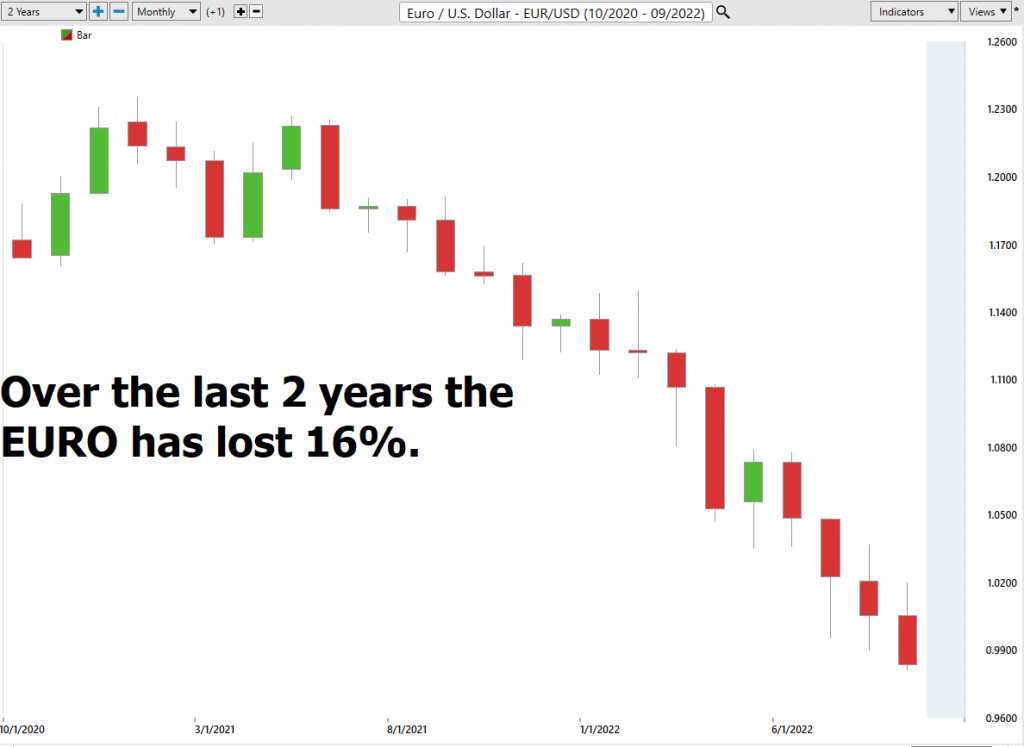
More importantly, the 10-year Euro chart keeps making new ten-year lows.
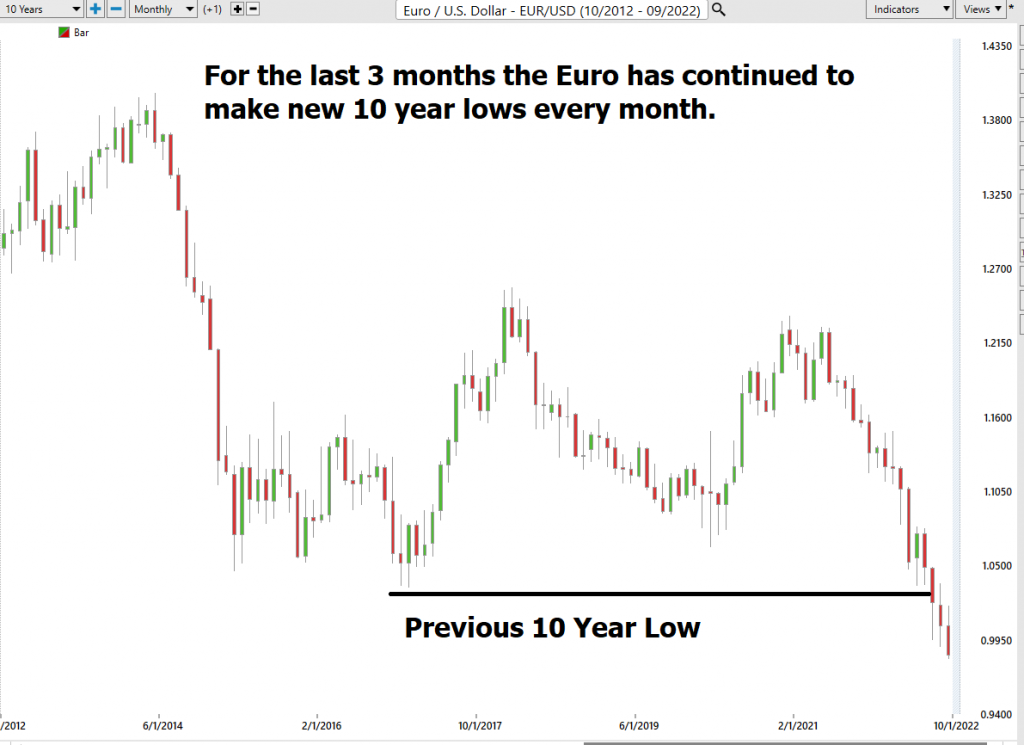
In other words, there is a whole lot of selling of the EURO going on. The marketplace is literally asking the question, what reason is there to own the EURO right now?
More importantly, look at the correlation between the S&P 500 Index and the EURO. On the Weekly Charts over the past year, the correlation is 81%. This means that 81% of the time they move in the same direction on the weekly charts.
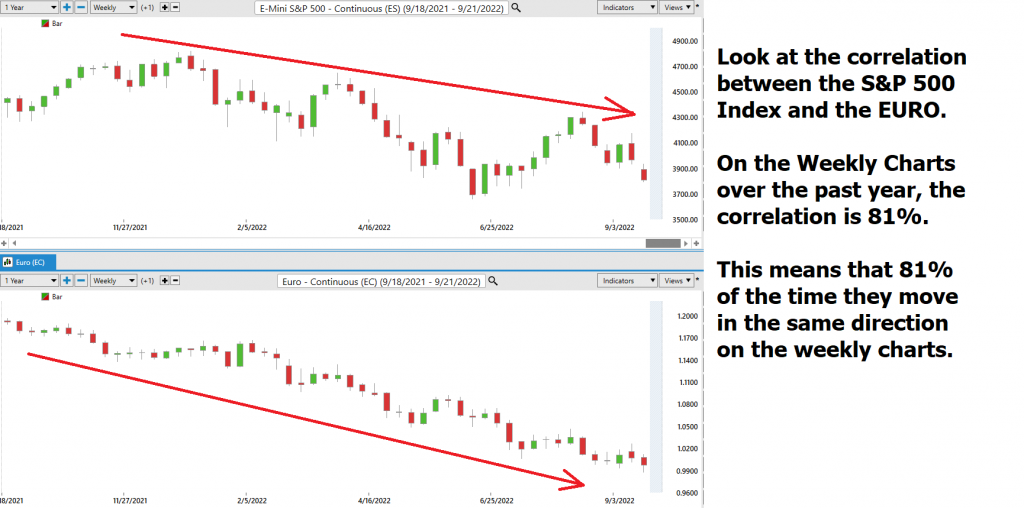
In keeping with the theme of asking intelligent questions:
- Where does all the scared EURO money go?
- What needs to happen to divorce this correlation moving forward?
- Where are the safe havens for investors now?
- How does a weak euro affect the G8 nations?
- Which stocks have large exposure to Europe and the Euro? How have they performed so far?
The Group of 8, or G8, is an annual summit meeting of eight of the world’s wealthiest nations. The forum provides a venue for discussing global economic issues and shaping economic policy. The member nations are Canada, France, Germany, Italy, Japan, Russia, the United Kingdom, and the United States. In addition to the annual summit, the G8 nations also meet periodically to discuss economic issues at ministerial-level meetings.
The GDPs of the G8 nations account for roughly two-thirds of the world’s GDP. To be eligible for membership in the G8, a nation must have a GDP that ranks among the top 10 in the world. The G8 nations typically meet once a year, although emergency meetings can be convened if necessary. At the summit, heads of state and government discuss global economic issues and formulate policies aimed at improving the global economy.
By simply looking at the G8 membership we quickly can discern that only Canada, Japan, Russia, and the United States are outside of the Eurozone. Over the last 2 years the Canadian dollar is flat in terms of overall performance.
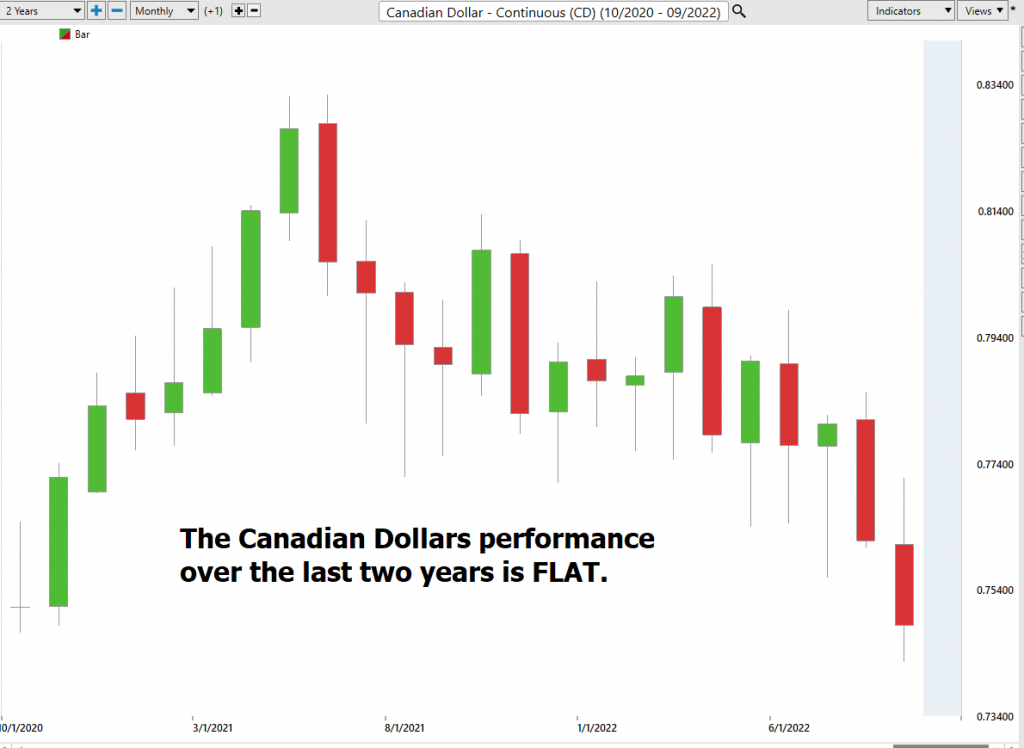
The Japanese Yen is down 27% over the last two years.
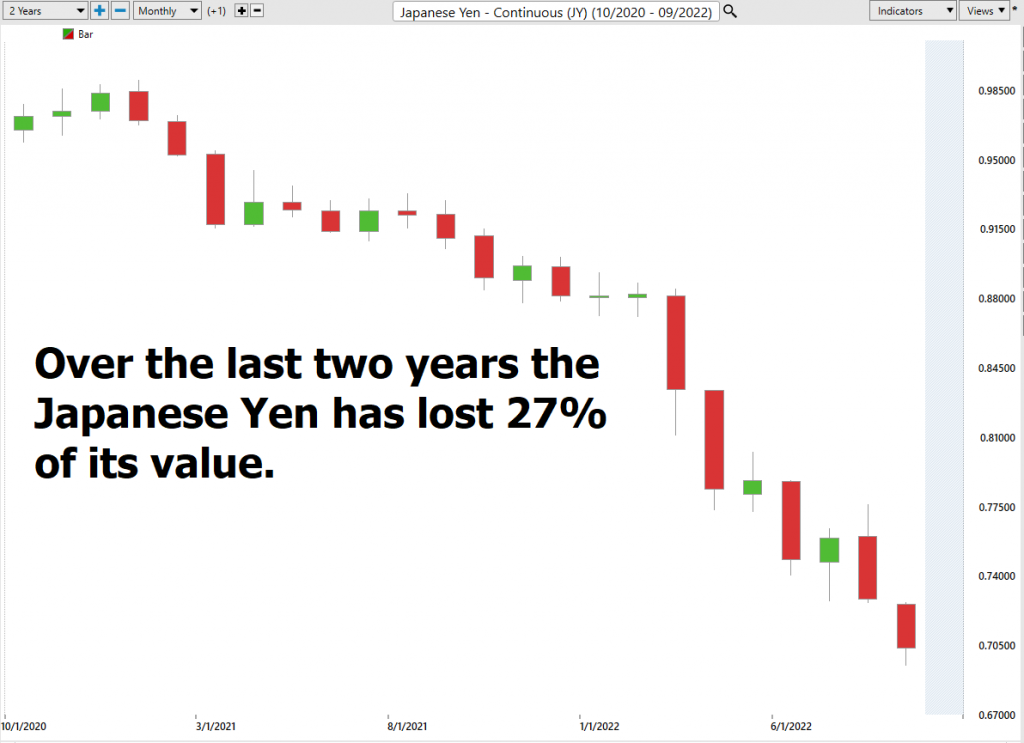
So, from a simple macro-economic investing standpoint the only two remaining countries in the G8 are the United States and Russia.
Where are the trading opportunities in a macroeconomic environment that could see WORLD GDP massively contract in the next year, based upon a worst-case scenario unfolding in Europe? Europe’s GDP in 2021 was 14.45 trillion Euros and is considered the third largest GDP bloc in the world.
Which American companies have large exposure to Japan and how have they performed so far?
The U.S. Dollar as the world’s Reserve Currency acts like a vacuum cleaner attracting FIAT money from all over the world as foreign markets start to implode. The challenge in thinking about all of this, calls for objectivity. The U.S. dollar increasing in value is not a sign of economic health. It is an indication that the U.S. dollar is doing better than other currencies which are slowly being decimated. As a fiat currency, the U.S. Dollar is the cleanest dirty shirt on the rack.
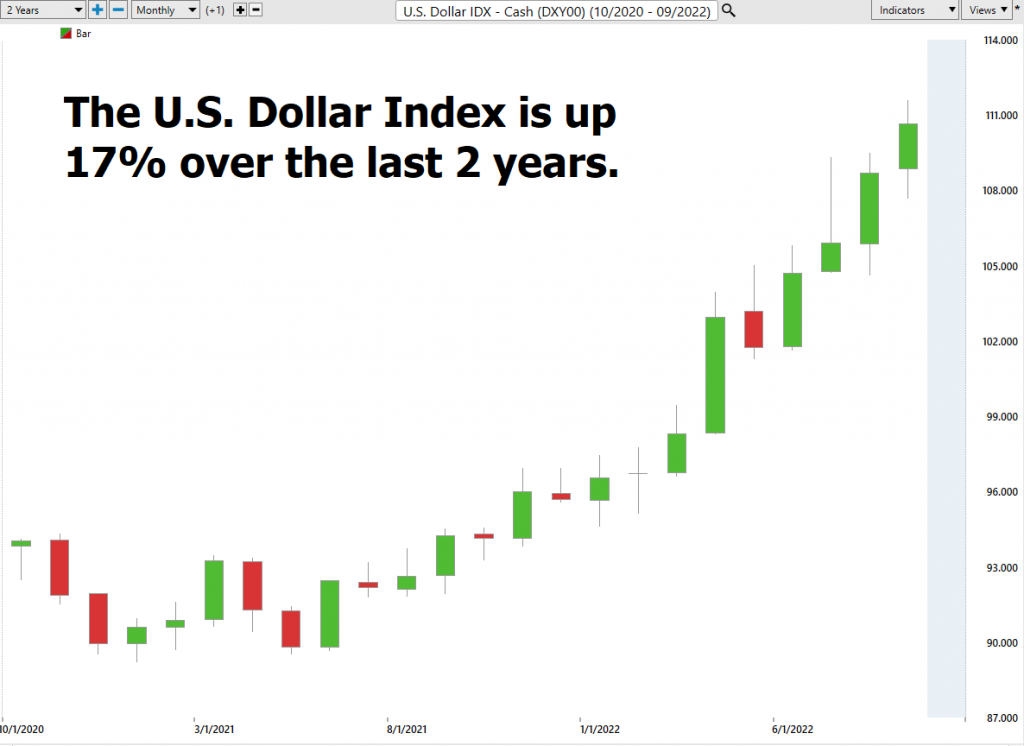
So where is the opportunity in all this madness?
First suggestion: to seize opportunity you’re going to have to recognize the short side of the market.
Most people when they are new to trading think of UP being good and down being bad. But markets fluctuate and continuously reprice themselves based upon the free-flowing information which they are continuously digesting.
Economies are constantly changing, and this is reflected in the prices of goods and services in the marketplace. When a big economic event occurs, markets will “reprice” themselves to take the new information into account. This can happen very quickly, as traders facilitate trade and investors redefine value. In some cases, markets may overreact to news, leading to prices that are either too high or too low. But incredible opportunity exists by exploring trading opportunities in falling markets.
What I’m betting on from all of the questions asked so far is that in the next six months we will see a period of rising volatility across all markets. Volatility creates uncertainty which can lead to large fluctuations in prices as businesses & consumers postpone buying/selling decisions awaiting more information on which to base their decisions. In times of political or economic uncertainty or when natural disasters strike, we often see panic buying (or selling) as people scramble to stock up on supplies (or unload them before they lose all their value). This further exacerbates price volatility as sudden shifts in buying patterns throw equilibrium off balance again.
For seasoned traders this is a trading bonanza and a huge opportunity for gain.
I am looking for opportunities to sell the EURO short. It is my opinion, that Europe is in for a horrific 6-month time frame.
It all starts with intelligent questions.
But where the rubber meets the road is with the conclusions that you reach.
How do you go about making sense of it all?
My suggestion is that you consider learning how to trade with artificial intelligence to make more informed trading decisions in the current economic environment.
DEBT continues to pile up.
Currency debasement and loss of purchasing power are everywhere you look today.
As you confront what is happening in Europe and the rest of the world, how confident are you that your portfolio will maintain its purchasing power moving forward?
What has your performance been like over the past two years which have seen unparalleled money supply creation by the Fed and sky-high inflation levels?
I’d like to invite you to consider utilizing artificial intelligence in your portfolio decision-making process.
Finding value is becoming a completely consuming activity on the part of traders and investors. The target moves quickly based upon too many factors that remain unseen to the naked eye.
It’s all about getting on the right side, of the right trend at the right time.
Most traders have problems with the timing of their trades.
If you want to win, it’s all about who has the best tools. Artificial intelligence excels at keeping traders on the right side of the right trend at the right time.
Let’s get candid here:
- The market is brutally honest – there are winners and losers.
- It’s very black and white.
- If you are going to win, someone else must lose.
- If survival of the fittest makes you uneasy, stay out of the financial markets.
We live in unique times. The Printing Press is diluting the value of our money and increasing risk.
Interest rates have been manipulated by Central banks for 14 years and created massive distortions.
Are you capable of finding those markets with the best risk/reward ratios out of the thousands of trading opportunities that exist?
Knowledge. Useful knowledge. And its application is what A.I. delivers.
You should find out. Join us for a FREE, Live Training.
Discover why Vantagepoint’s artificial intelligence is the solution professional traders go-to for less risk, more rewards, and guaranteed peace of mind.
Pay Attention.
Visit with us and check out the A.I. at our Next Live Training.
It’s not magic. It’s machine learning.
Make it count.
IMPORTANT NOTICE!
THERE IS SUBSTANTIAL RISK OF LOSS ASSOCIATED WITH TRADING. ONLY RISK CAPITAL SHOULD BE USED TO TRADE. TRADING STOCKS, FUTURES, OPTIONS, FOREX, AND ETFs IS NOT SUITABLE FOR EVERYONE.
DISCLAIMER: STOCKS, FUTURES, OPTIONS, ETFs AND CURRENCY TRADING ALL HAVE LARGE POTENTIAL REWARDS, BUT THEY ALSO HAVE LARGE POTENTIAL RISK. YOU MUST BE AWARE OF THE RISKS AND BE WILLING TO ACCEPT THEM IN ORDER TO INVEST IN THESE MARKETS. DON’T TRADE WITH MONEY YOU CAN’T AFFORD TO LOSE. THIS ARTICLE AND WEBSITE IS NEITHER A SOLICITATION NOR AN OFFER TO BUY/SELL FUTURES, OPTIONS, STOCKS, OR CURRENCIES. NO REPRESENTATION IS BEING MADE THAT ANY ACCOUNT WILL OR IS LIKELY TO ACHIEVE PROFITS OR LOSSES SIMILAR TO THOSE DISCUSSED ON THIS ARTICLE OR WEBSITE. THE PAST PERFORMANCE OF ANY TRADING SYSTEM OR METHODOLOGY IS NOT NECESSARILY INDICATIVE OF FUTURE RESULTS. CFTC RULE 4.41 – HYPOTHETICAL OR SIMULATED PERFORMANCE RESULTS HAVE CERTAIN LIMITATIONS. UNLIKE AN ACTUAL PERFORMANCE RECORD, SIMULATED RESULTS DO NOT REPRESENT ACTUAL TRADING. ALSO, SINCE THE TRADES HAVE NOT BEEN EXECUTED, THE RESULTS MAY HAVE UNDER-OR-OVER COMPENSATED FOR THE IMPACT, IF ANY, OF CERTAIN MARKET FACTORS, SUCH AS LACK OF LIQUIDITY. SIMULATED TRADING PROGRAMS IN GENERAL ARE ALSO SUBJECT TO THE FACT THAT THEY ARE DESIGNED WITH THE BENEFIT OF HINDSIGHT. NO REPRESENTATION IS BEING MADE THAT ANY ACCOUNT WILL OR IS LIKELY TO ACHIEVE PROFIT OR LOSSES SIMILAR TO THOSE SHOWN.


